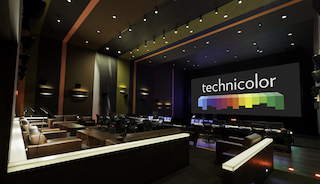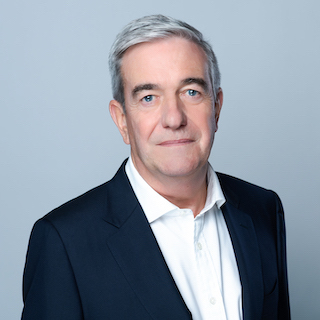 After more than a century as a key player in media and entertainment, Technicolor has gone through many changes in recent years. Today the company consists of four distinct businesses. Technicolor Creative Studios includes Technicolor Pre-Production, MPC, Mr. X, The Mill and Mikros Animation. Technicolor Connected Home is focused on the designing of broadband gateways and Android set-top boxes, and innovating in IoT, broadband fiber 2.5G and 10G. Technicolor Home Entertainment Services is a leader in the manufacturing and distribution of DVDs and Blu-ray discs, and non-packaged media innovations. And Technicolor Trademark Licensing, which manages brand licensing opportunities for consumer electronic trademarks including RCA and Thompson. Richard Moat has spent the past three decades as a top executive at several telecommunications companies including Tiaxa Ltd. In Birmingham, United Kingdom and eir Ireland in Dublin. He said his focus has always been on driving positive change in organizations looking to grow and improve their performance. He joined Technicolor as CEO in November 2019. I recently spoke with Moat via email. Our conversation began with the fact that not long after he stepped into his new position, the pandemic changed everything.
After more than a century as a key player in media and entertainment, Technicolor has gone through many changes in recent years. Today the company consists of four distinct businesses. Technicolor Creative Studios includes Technicolor Pre-Production, MPC, Mr. X, The Mill and Mikros Animation. Technicolor Connected Home is focused on the designing of broadband gateways and Android set-top boxes, and innovating in IoT, broadband fiber 2.5G and 10G. Technicolor Home Entertainment Services is a leader in the manufacturing and distribution of DVDs and Blu-ray discs, and non-packaged media innovations. And Technicolor Trademark Licensing, which manages brand licensing opportunities for consumer electronic trademarks including RCA and Thompson. Richard Moat has spent the past three decades as a top executive at several telecommunications companies including Tiaxa Ltd. In Birmingham, United Kingdom and eir Ireland in Dublin. He said his focus has always been on driving positive change in organizations looking to grow and improve their performance. He joined Technicolor as CEO in November 2019. I recently spoke with Moat via email. Our conversation began with the fact that not long after he stepped into his new position, the pandemic changed everything.
Digital Cinema Report: You joined Technicolor at the end of 2019. We all know what happened in early 2020. What impact did the COVID-19 pandemic initially have on Technicolor?
Richard Moat: For our creative studios, we had to shift to a work from home environment practically overnight. With the level of computing power and connectivity our artists require, this was no small technological feat. I’m incredibly proud of our teams who made that happen.
 During the pandemic it became even more apparent to the industry as to the creative and operational value of our amazing digital artistry. Visual effects [have] played an invaluable role in helping to restart live-action productions, and we’ve seen the resilience of animated content during the pandemic. Animation is not dependent on live-action production, making it as close to “pandemic-proof” as possible (I think we have all seen pictures of our favorite actresses and actresses doing voiceovers in their closets, etc.). We were able to actually create and deliver almost 90 percent of Paw Patrol: The Movie with our artists at home. Animated content is also a key driver of new subscriptions for many streaming platforms (think of all the parents who turned to animated content for their kids during the pandemic) and therefore, a key strategy for us.
During the pandemic it became even more apparent to the industry as to the creative and operational value of our amazing digital artistry. Visual effects [have] played an invaluable role in helping to restart live-action productions, and we’ve seen the resilience of animated content during the pandemic. Animation is not dependent on live-action production, making it as close to “pandemic-proof” as possible (I think we have all seen pictures of our favorite actresses and actresses doing voiceovers in their closets, etc.). We were able to actually create and deliver almost 90 percent of Paw Patrol: The Movie with our artists at home. Animated content is also a key driver of new subscriptions for many streaming platforms (think of all the parents who turned to animated content for their kids during the pandemic) and therefore, a key strategy for us.
For the last four years, Technicolor has pioneered virtual production and the fast prototyping of content thanks to game engine technology. We are at the forefront of this critical approach to filmmaking which enables creatives to see what the CGI and visual effects will look like on set and in real time, saving hours of back and forth and helping directors achieve their creative vision faster. With our new Scout App released in November 2020, any director can visualize their movie’s CGI characters anywhere using an iPad, making the creative process of every shot infinitely faster. This time saved in what used to be mundane production tasks can now be reinvested in perfecting the quality of characters, landscapes and visual effects, ensuring Technicolor’s market leadership when it comes to visual excellence.
Ultimately Technicolor was better prepared than its competition to weather the slowdown in live-action production caused by COVID while also enabling us to grow market share, invest in technology and attract top talent.
DCR: What, if any, pandemic-related hurdles remain?
 RM: Demand is strong, and the post-pandemic recovery is there. Our perspectives for the rest of 2021 and then 2022 and beyond are really positive. Technicolor Creative Studios has secured a large portion of its target sales pipeline for 2021 and 2022, a milestone that also demonstrates the tangible recovery of our industry. Our DVD services have seen a four percent increase in total replicated disc activity, showing the resiliency of packaged media. Our broadband gateways division is also performing well thanks to the very strong demand in North America, Asia, and Europe. One challenge we have, just like everyone else around the world, is the component shortage crisis, which caused a number of sales to be pushed back to the second half of the year.
RM: Demand is strong, and the post-pandemic recovery is there. Our perspectives for the rest of 2021 and then 2022 and beyond are really positive. Technicolor Creative Studios has secured a large portion of its target sales pipeline for 2021 and 2022, a milestone that also demonstrates the tangible recovery of our industry. Our DVD services have seen a four percent increase in total replicated disc activity, showing the resiliency of packaged media. Our broadband gateways division is also performing well thanks to the very strong demand in North America, Asia, and Europe. One challenge we have, just like everyone else around the world, is the component shortage crisis, which caused a number of sales to be pushed back to the second half of the year.
We are responding to the effects of the COVID variants as they spread. We’ve figured out a way for our artists to work from home, however there is still an enormous amount to be said for in-person collaboration (I think many of us are tired of virtual meetings!). So, we continue to look at hybrid working models which bring the critical human and in-person elements together, while ensuring a safe working environment. Overall, we have been able to maintain our creativity, our quality of our work, and our project deadlines during an indescribable moment in history, and it is really an incredible testament to the resiliency of our teams.
DCR: Technicolor is a much different company today than it was when you joined. What changes are you most pleased with?
RM: Technicolor needed a reboot even before the pandemic. Since coming on board as CEO in November 2019, I have worked to rapidly transform the company – positioning it for innovation and growth. Over the last two years, we have re-engineered Technicolor’s operations, financial footing and global footprint to be more scalable, focused, innovative, faster to market and artistically cutting-edge.
Part of this reboot included finding synergies within teams and across a global footprint of studios, and transforming historically siloed teams, with Technicolor Creative Studios being the prime example. We recently redeveloped Technicolor’s Production Services division, including The Mill, MPC (Film, Episodic & Advertising), Mikros Animation, Mr. X and Technicolor Pre-Production, into a collaborative network of studios called Technicolor Creative Studios. We restructured and reorganized to ensure faster time to market (and that Technicolor outperforms its reputation for managing complex production projects on budget and deadline) and to enable global talent to work on the best projects – even during pandemics and global crisis like the one we are experiencing. The company has also focused on “cross fertilization” – creating more bridges between the international offices and brands. This creates a powerful international community of artists that outlearns the rest of the industry and sets the gold standard of visual effects.
The company is in the strongest financial position it has been in for years, and the outlook is positive. Even against the background of this historic moment in time, we are delivering on what we promised to our employees, to our clients, and to our investors.
DCR: What do the ongoing developments in streaming and video on demand mean for Technicolor?
 RM: The ways in which our partners and clients engage with their audiences is changing fast, with higher expectations on quality, quantity, and creativity. Technicolor anticipated the shift, which is often dependent on stunning VFX and Animation. We evolved our teams and resources for this shift and continue to be the leading partner to the world’s premier storytellers.
RM: The ways in which our partners and clients engage with their audiences is changing fast, with higher expectations on quality, quantity, and creativity. Technicolor anticipated the shift, which is often dependent on stunning VFX and Animation. We evolved our teams and resources for this shift and continue to be the leading partner to the world’s premier storytellers.
DCR: You seem particularly bullish on the visual effects business. Why is that?
RM: VFX is a growing market valued at $26.6 billion worldwide. This growth is mostly propelled by streaming, VOD, and online advertising. Content is getting visually “bigger,” brands are getting incredibly more creative and sophisticated, and when iconic creatives have a story to tell, they come to Technicolor’s Creative Studios to continually exceed expectations. Technicolor is not just the leader in VFX and CGI on paper; we have longstanding and trusted relationships with Hollywood studios, and a positive reputation for successful collaboration across all aspects of production, both creatively and operationally. As content experiences enter a golden age of proliferation, distribution and innovation, Technicolor’s value proposition has never been more strategic or timely.
DCR: Where does Technicolor go from here?
RM: Technicolor is looking at an impressive pipeline of work across the film, episodic, advertising, games, and live events spaces, where Technicolor Creative Studios will continue to move the needle of innovation and support the biggest projects in the world for entertainment and advertising.
We are also investing in and leading the charge in innovation surrounding exciting new spaces such as augmented reality, virtual reality, artificial intelligence, virtual production, live animation, the metaverse, 5G and more.
We believe we are stronger if we operate as a closer network of creative studios sharing learnings, technology, processes, and operations. This change also provides a bigger platform for our talent to develop and grow their careers across multiple skills, capabilities, and industry sectors. We are currently hiring 4,000 artists and technicians.
With the transformation of our Creative Studios division and the synergies it produces, we are better positioned than ever to further invest in new technology platforms, facilitate a broader creative offering, and meet the changing needs of our clients, partners, and collaborators in exciting, innovative ways.
We are writing the sequel to Technicolor’s 105-year story, and I’m excited to see it play out.
